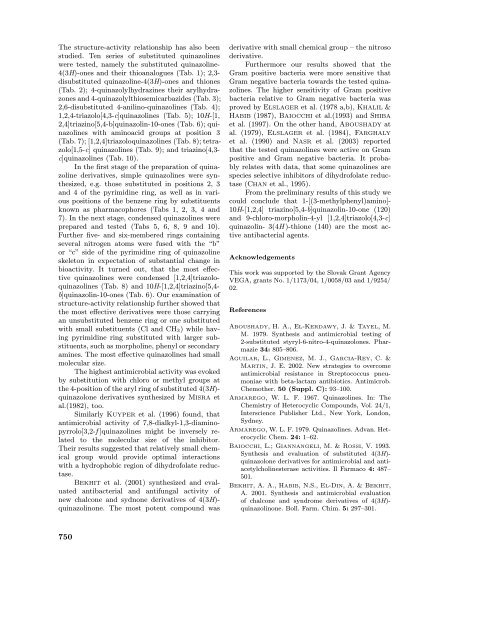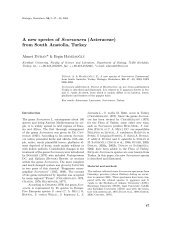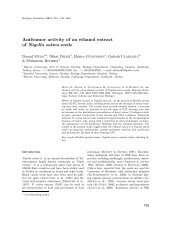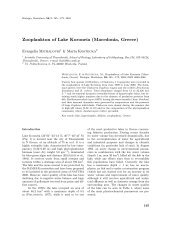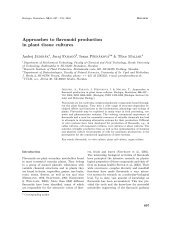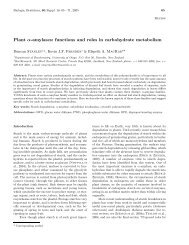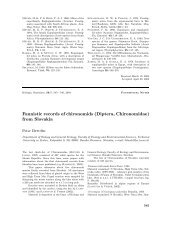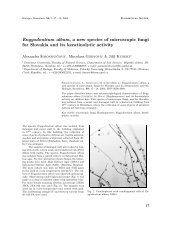In vitro antibacterial activity of ten series of substituted quinazolines
In vitro antibacterial activity of ten series of substituted quinazolines
In vitro antibacterial activity of ten series of substituted quinazolines
You also want an ePaper? Increase the reach of your titles
YUMPU automatically turns print PDFs into web optimized ePapers that Google loves.
The structure-<strong>activity</strong> relationship has also been<br />
studied. Ten <strong>series</strong> <strong>of</strong> <strong>substituted</strong> <strong>quinazolines</strong><br />
were tested, namely the <strong>substituted</strong> quinazoline-<br />
4(3H)-ones and their thioanalogues (Tab. 1); 2,3di<strong>substituted</strong><br />
quinazoline-4(3H)-ones and thiones<br />
(Tab. 2); 4-quinazolylhydrazines their arylhydrazones<br />
and 4-quinazolylthiosemicarbazides (Tab. 3);<br />
2,6-di<strong>substituted</strong> 4-anilino-<strong>quinazolines</strong> (Tab. 4);<br />
1,2,4-triazolo[4,3-c]<strong>quinazolines</strong> (Tab. 5); 10H-[1,<br />
2,4]triazino[5,4-b]quinazolin-10-ones (Tab. 6); <strong>quinazolines</strong><br />
with aminoacid groups at position 3<br />
(Tab. 7); [1,2,4]triazolo<strong>quinazolines</strong> (Tab. 8); tetrazolo[1,5-c]<br />
<strong>quinazolines</strong> (Tab. 9); and triazino[4,3c]<strong>quinazolines</strong><br />
(Tab. 10).<br />
<strong>In</strong> the first stage <strong>of</strong> the preparation <strong>of</strong> quinazoline<br />
derivatives, simple <strong>quinazolines</strong> were synthesized,<br />
e.g. those <strong>substituted</strong> in positions 2, 3<br />
and 4 <strong>of</strong> the pyrimidine ring, as well as in various<br />
positions <strong>of</strong> the benzene ring by substituents<br />
known as pharmacophores (Tabs 1, 2, 3, 4 and<br />
7). <strong>In</strong> the next stage, condensed <strong>quinazolines</strong> were<br />
prepared and tested (Tabs 5, 6, 8, 9 and 10).<br />
Further five- and six-membered rings containing<br />
several nitrogen atoms were fused with the “b”<br />
or “c” side <strong>of</strong> the pyrimidine ring <strong>of</strong> quinazoline<br />
skeleton in expectation <strong>of</strong> substantial change in<br />
bio<strong>activity</strong>. It turned out, that the most effective<br />
<strong>quinazolines</strong> were condensed [1,2,4]triazolo<strong>quinazolines</strong><br />
(Tab. 8) and 10H-[1,2,4]triazino[5,4b]quinazolin-10-ones<br />
(Tab. 6). Our examination <strong>of</strong><br />
structure-<strong>activity</strong> relationship further showed that<br />
the most effective derivatives were those carrying<br />
an un<strong>substituted</strong> benzene ring or one <strong>substituted</strong><br />
with small substituents (Cl and CH3) while having<br />
pyrimidine ring <strong>substituted</strong> with larger substituents,<br />
such as morpholine, phenyl or secondary<br />
amines. The most effective <strong>quinazolines</strong> had small<br />
molecular size.<br />
The highest antimicrobial <strong>activity</strong> was evoked<br />
by substitution with chloro or methyl groups at<br />
the 4-position <strong>of</strong> the aryl ring <strong>of</strong> <strong>substituted</strong> 4(3H)quinazolone<br />
derivatives synthesized by MISRA et<br />
al.(1982), too.<br />
Similarly KUYPER et al. (1996) found, that<br />
antimicrobial <strong>activity</strong> <strong>of</strong> 7,8-dialkyl-1,3-diaminopyrrolo[3,2-f<br />
]<strong>quinazolines</strong> might be inversely related<br />
to the molecular size <strong>of</strong> the inhibitor.<br />
Their results suggested that relatively small chemical<br />
group would provide optimal interactions<br />
with a hydrophobic region <strong>of</strong> dihydr<strong>of</strong>olate reductase.<br />
BEKHIT et al. (2001) synthesized and evaluated<br />
<strong>antibacterial</strong> and antifungal <strong>activity</strong> <strong>of</strong><br />
new chalcone and sydnone derivatives <strong>of</strong> 4(3H)quinazolinone.<br />
The most po<strong>ten</strong>t compound was<br />
750<br />
derivative with small chemical group – the nitroso<br />
derivative.<br />
Furthermore our results showed that the<br />
Gram positive bacteria were more sensitive that<br />
Gram negative bacteria towards the tested <strong>quinazolines</strong>.<br />
The higher sensitivity <strong>of</strong> Gram positive<br />
bacteria relative to Gram negative bacteria was<br />
proved by ELSLAGER et al. (1978 a,b), KHALIL &<br />
HABIB (1987), BAIOCCHI et al.(1993) and SHIBA<br />
et al. (1997). On the other hand, ABOUSHADY at<br />
al. (1979), ELSLAGER et al. (1984), FARGHALY<br />
et al. (1990) and NASR et al. (2003) reported<br />
that the tested <strong>quinazolines</strong> were active on Gram<br />
positive and Gram negative bacteria. It probably<br />
relates with data, that some <strong>quinazolines</strong> are<br />
species selective inhibitors <strong>of</strong> dihydr<strong>of</strong>olate reductase<br />
(CHAN et al., 1995).<br />
From the preliminary results <strong>of</strong> this study we<br />
could conclude that 1-[(3-methylphenyl)amino]-<br />
10H-[1,2,4] triazino[5,4-b]quinazolin-10-one (120)<br />
and 9-chloro-morpholin-4-yl [1,2,4]triazolo[4,3-c]<br />
quinazolin- 3(4H )-thione (140) are the most active<br />
<strong>antibacterial</strong> agents.<br />
Acknowledgements<br />
This work was supported by the Slovak Grant Agency<br />
VEGA, grants No. 1/1173/04, 1/0058/03 and 1/9254/<br />
02.<br />
References<br />
ABOUSHADY, H.A.,EL-KERDAWY, J.&TAYEL, M.<br />
M. 1979. Synthesis and antimicrobial testing <strong>of</strong><br />
2-<strong>substituted</strong> styryl-6-nitro-4-quinazolones. Pharmazie<br />
34: 805–806.<br />
AGUILAR, L.,GIMENEZ, M. J., GARCIA-REY, C.&<br />
MARTIN, J. E. 2002. New strategies to overcome<br />
antimicrobial resistance in Streptococcus pneumoniae<br />
with beta-lactam antibiotics. Antimicrob.<br />
Chemother. 50 (Suppl. C): 93–100.<br />
ARMAREGO, W. L. F. 1967. Quinazolines. <strong>In</strong>: The<br />
Chemistry <strong>of</strong> Heterocyclic Compounds, Vol. 24/1,<br />
<strong>In</strong>terscience Publisher Ltd., New York, London,<br />
Sydney.<br />
ARMAREGO, W. L. F. 1979. Quinazolines. Advan. Heterocyclic<br />
Chem. 24: 1–62.<br />
BAIOCCHI, L.;GIANNANGELI, M.&ROSSI, V. 1993.<br />
Synthesis and evaluation <strong>of</strong> <strong>substituted</strong> 4(3H)quinazolone<br />
derivatives for antimicrobial and antiacetylcholinesterase<br />
activities. Il Farmaco 4: 487–<br />
501.<br />
BEKHIT, A.A.,HABIB, N.S., EL-DIN, A.&BEKHIT,<br />
A. 2001. Synthesis and antimicrobial evaluation<br />
<strong>of</strong> chalcone and syndrome derivatives <strong>of</strong> 4(3H)quinazolinone.<br />
Boll. Farm. Chim. 5: 297–301.


